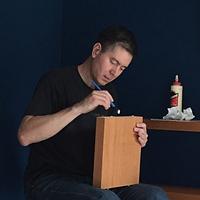Share your craft projects
Make new craft buddies
Ask craft questions
Blog your craft journey

Ron Stewart
861 posts
and
24 followers
in about 3 years
in about 3 years
More from Ron Stewart
Mobile Sewing Thread Storage Rack #6: Prefinishing (Partially) and Assembling the Racks
This is
part 6
in a
11 part
series:
Mobile Sewing Thread Storage Rack
...
-
Installing the Tilt Stop Magnets
-
Prefinishing (Partially) and Assembling the Racks
-
A Brief Detour: Making Custom Washers
...
...
- Installing the Tilt Stop Magnets
- Prefinishing (Partially) and Assembling the Racks
- A Brief Detour: Making Custom Washers
...

In preparation for assembling the racks, I prefinished their interior sides (no pictures of that) along with the spool blocks and tilt stops. I used satin Arm-R-Seal for the project.
For the spool blocks, I nailed 36 finishing nails into an MDF scrap to act as a drying rack. I finished the blocks one at a time, using a short length of 1/4" dowel as a handle. Using a blue shop towel, I scrubbed in a coat of varnish into each block. It was a pain getting the finish into the bobbin wells without it pooling, so I was focused more on coloring and sealing the wood instead of building the finish. After I finished each block, I carefully slipped the pivot hole opposite the makeshift handle onto a finishing nail and removed the handle. The blocks tended to rotate around, so I had to keep repositioning them to avoid contact with other blocks (or so the contact points were on edges or bottom sides).
I liked how the drying blocks looked. The rack was sort of a kinetic sculpture. The next day, I wiped on another coat. I didn’t bother with the bobbin wells, and I tried to apply a smooth coat. I stopped after this coat.

Prefinishing the tilt stops was easy, but I had to tape off the ends that would receive glue. That took forever.

The actual finishing was easier. I just held the taped end and wiped on a coat. The taped ends gave me an easy way to create another makeshift drying rack. The next day, I wiped on another coat.

The last step before I could assemble the rack was preparing the 1/4" pivot dowels. I had to shorten 1” long dowels to just over 3/4". I did that using my crosscut sled, supporting the dowel with a notched piece of scrap.


The dowels fit too tightly into their holes, so I compressed them by dropping them on the concrete floor and rolling a piece of 2x4 over them, applying just enough pressure to compress the flutes. (I typically do that for my dowel joints anyway because often the dowels fit too tightly.) It’s not an exact process, and some blocks pivot more freely than others. I figured that any snug ones would tilt more freely over time as they are used.
I had drilled the dowel holes for the joints between the racks’ sides, tops, and bottoms earlier, so I was ready to glue.

As glue-ups go, it was incredibly easy—four joints and just two clamps. The only tricky part was making sure I had all the blocks facing the right direction. On one rack, I had one block turned around, but I caught my mistake before the glue started to set. That would have been a disaster. Once these racks are assembled, they’re done. My design made no provisions for disassembly. (I could have used bolts or screws as pivots, but the heads would have been visible, and my wife vetoed that notion. I think the racks look better without visible screw heads too, but I always like to have a way to fix or tweak things. It just wasn't possible in this case.)

While waiting for the blocks and stops to dry, I addressed another loose end—drilling the 3/8” holes for the pivot dowels that would enable the outer racks to swivel open. I used my dowel jig again, and I again had to create shims to position the holes exactly where I needed them.

The next step was gluing on all the tilt stops, but I had one minor problem to address first. On two of the racks, the long sides were nice and flat. On another, one of the sides bowed out slightly. On the last, one of the sides was flat until about six inches from one side, where it flared out. The flare was the biggest worry, because it created a concavity that pressed on one of the blocks, making it hard to tilt (and scraping the inner side).
To flatten the bowed/flared sides, I clamped them to cauls (mine are straight, not slightly curved like they’re supposed to be). I hoped that the nine stops per rack would maintain the flatness after the glue-up. (It seemed to have worked well enough--that tight block rotated slightly easier in the end.)

Gluing on the stops was simple. I just used a lot less glue than usual, because I didn’t want to deal with squeeze-out on the racks’ inner sides. I just smeared on a thin layer of glue into the slots (trying to keep it more on the outside end).

Then I did the same with the ends of the stops.

I had cut the stops slightly oversized in case the rack sides weren’t perfectly flat, so I had to position them horizontally so their magnets lined up with their mates in the spool blocks. In cases where the blocks rotated easily, I heard a satisfying thwack as the block rotated to meet the stop, and I knew the alignment was correct. Other times, it wasn’t as clear, and I just lined things up by eye. (In the end, I think I have one block where the magnets aren’t lined up as well as I would have liked, but there’s not much I can do about that now.)
After the glue dried, I had to deal with the excess on the sides. I considered using a flush trimming bit on my router table, but I decided to use elbow grease and a sanding block, starting with 80-grit. That turned out to be easy; it just meant I’d have to do more sanding with progressively finer grits later.


Now I had to deal with the excess width.

I again hand sanded the excess off, and I also rounded over the edges by the pivot holes. The roundovers prevent those corners from scraping against the cart’s rear panel when the racks swing open.
With that, the racks were essentially done. They just needed final sanding, but I’ll do that later when I’m ready to apply finish. Now I can start on the cart.
6 Comments
Impressive amount of work! A lot to keep track of and it seems you are past that "no spares" fear zone 👍
Thanks, Splint. Yes, I was past most of the tricky stuff.
Ron,
What a design feat!
L/W
What a design feat!
L/W
“Those who would give up essential Liberty, to purchase a little temporary Safety, deserve neither Liberty nor Safety.” Benjamin Franklin
This is a very interesting build.
Thanks, L/W and Steve! It was definitely a challenging project, but a fun one too.
With the bows on the one rack, it took a leap of faith to glue in those stops. Your gamble paid off. It's all looking great.












